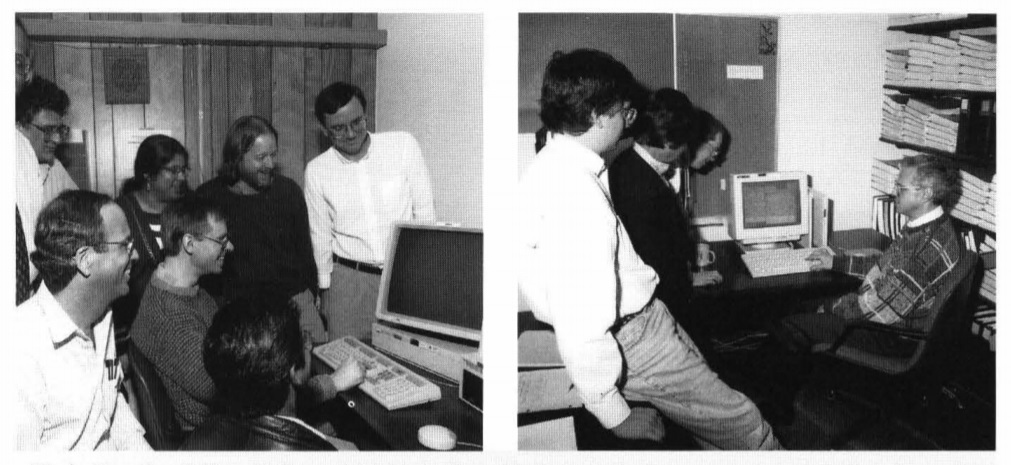Top Matters

Herb Greenlee, DZero (left), and Mel Schochet, CDF, push the buttons to electronically submit their collaborations' top quark discovery papers to Physical Review Letters on Friday, February 24.
The announcement at Fermilab on March 2 of the discovery of the top quark by the CDF and DZero collaborations marked a milestone not only in Fermilab history but in the science of particle physics. The top quark's discovery drew much attention. People called from Batavia, Boston and Bangladesh with questions about the newest member of the family of elementary particles. One question that almost everyone asked, in one form or another, was "So what?" They wanted to know, in simple terms, what the discovery of the top quark means, and why it is important. Why does the top quark matter?
Gotcha!
For almost 18 years, scientists looked for the top quark, because physics theory said it was there. A remarkably simple theoretical picture, the Standard Model, describes the elementary particles and forces of matter. Experiment after experiment has tried to find flaws in the Standard Model's predictions, but so far all the experimental evidence supports it. The Standard Model predicts six quarks; scientists had found only five. If the top quark hadn't turned up, it would have called the entire theory into question. Now, the discovery of the top quark provides strong evidence for the Standard Model.
It's Big
CDF and DZero have shown that the top quark is by far the most massive of all the fundamental particles, some 40 times heavier than the next heaviest quark, the bottom quark. "We have no idea at all why it weighs as much as gold," says CDF physicist Alvin Tollestrup. "It is only a little quark, and here it is weighing as much as a whole gold atom... No one was expecting that at all." Why is the top quark so heavy? The answer is connected to another question, perhaps the central unanswered question of particle physics: Why does matter-any matter-have mass? Although we don't know why the top quark is so heavy, some physicists believe that whatever causes mass is somehow more closely connected to the top quark than to any other particle. Precisely measuring the mass of the top quark may give us insight into the origin of mass.
From the Big Bang to Batavia
Top quarks flashed briefly into existence in the instants after the Big Bang at the beginning of the universe, and promptly disappeared for about 15 billion years. They had not been seen since, until they turned up in particle collisions at Fermilab. Of the world's accelerators, only the Tevatron is powerful enough to create top quarks. Studying top quarks may give us clues to understanding the origins of the universe.
Top Matters Now
Although the top quark did not stick around for long, it had a profound influence on how the universe turned out. The top quark's mass is linked to the mass of the proton, the basic unit of the atomic nucleus in everyday matter. "If top weighed 10 times more or less," says Fermilab theorist Chris Quigg, "the proton's mass would be shifted up or down by about 20 percent, through top's effect on the evolution of the strong force that holds up and down quarks together inside the proton. This world would have a very different character."
What Use is It?
For now, the best use of the top quark is to make the universe more understandable. "We can't predict the eventual practical value of our new knowledge," says DZero physicist John Womersley, "but experience has taught us the worth of physics research as a source of discoveries that change not only our understanding of the world but our world itself." In the 1920s, for example, discoveries in atomic physics led to the theory of the structure and behavior of atoms we call quantum mechanics, and to an utterly new understanding of nature. At the time, no one suspected that from this new knowledge would come lasers and solar cells and, in 1947, the invention of the transistor, the basis of all modern electronics and the age of information. The discoveries we make today affect the kind of future we can expect tomorrow.
What's Next?
The discovery of the top quark marks the end of one scientific quest and the beginning of another-like touching the shores of a new scientific continent. Now experimenters at Fermilab can begin to explore the unknown territory they have found. Watch these pages to learn what they discover!


